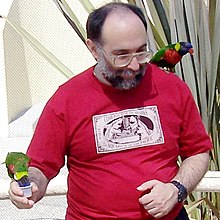Arthur Rubin
Contributors to Wikimedia projects
 Article Images
Article Images
Arthur Leonard Rubin (born 1956) is an American mathematician.
Arthur Rubin | |
|---|---|
 at the Aquarium of the Pacific in August 2006 | |
| Born | 1956 (age 67–68) |
| Nationality | American |
| Citizenship | United States |
| Alma mater | Caltech |
| Scientific career | |
| Fields | Mathematician |
| Doctoral advisor | Alexander S. Kechris |
Biography
As an undergraduate he placed among the top five competitors in the William Lowell Putnam Competition on four occasions (1970–73),[1] a feat matched by only six other undergraduate students since the first competition in 1938.[2] He first became Putnam Fellow at the age of 14 (in 1970), making him the youngest person (till date) to have achieved this feat.[3] This achievement was lauded in the popular press, which described him as a genius, "Arthur Rubin is to the mathematics world what Pegasus would be to the Kentucky Derby."[4] Rubin's undergraduate adviser, Gary Lorden, was described as saying that a person of Rubin's mathematical ability shows up in the United States "about once in every ten years".[4] His mother was J. E. H. Rubin, a professor of mathematics at Purdue University for over 35 years, and his father, Herman Rubin, is a professor of statistics at the same university.[5]
In 1978, Rubin earned his Ph.D. at the California Institute of Technology, under the direction of Alexander S. Kechris. Rubin's dissertation was entitled "Free Algebras in Von Neumann–Bernays–Gödel Set Theory and Positive Elementary Inductions in Reasonable Structures".[6]
Shortly after, in 1979, Rubin co-authored a paper on list coloring of graphs with Paul Erdős, giving him an Erdős number of 1.[7] In addition, Rubin has published papers on the following topics:
Other notable accomplishments
- U.S. patent 7,089,452 in 2006
- Third place tie in the first USA Mathematical Olympiad (1972)[12]
- Ran for California State Assembly (55th district) on the Libertarian Party ticket in the early 1980s[13]
References
- ^ editors Gerald L. Alexanderson (1985). The William Lowell Putnam Mathematical Competition Problems and Solutions 1965-1984. Mathematical Association of America. pp. 141–142. ISBN 0883854635. ;
- ^ Mathematical Association of America. "The Mathematical Association of America's William Lowell Putnam Competition". Retrieved 2006-04-25.
Individual Putnam Fellows: Arthur L. Rubin, California Institute of Technology
- ^ Joseph Gallian. "The Putnam Competition from 1938-2009" (PDF). Retrieved 2010-09-25.
- ^ a b Stingley, Jim (May 13, 1974). "Caltech Math Whiz". Los Angeles Times.
Arthur Rubin is to the mathematics world what Pegasus would be to the Kentucky Derby. In the universe of calculation, he is a 400-pound wrestler matched against Don Knotts.
- ^ Dinah L. McClure, editor (2002). "Obituary: J. E. H. Rubin" (PDF). Sequel (38): 2. Archived from the original (PDF) on 2006-09-02. Retrieved 2006-04-25.
Professor Jean E. Hirsh Rubin, 75, died on October 25, 2002, in Lafayette. Born on October 29, 1926 in New York City, she had lived in West Lafayette since 1967. She received her M.A. degree from Queens College, the M.S. from Columbia University and her Ph.D from Stanford University. She was a Professor of Mathematics at Purdue for 35 years. She married Herman Rubin, Professor of Statistics, in 1952. She is also survived by her son, Arthur Rubin of Brea, California, and her daughter, Leonore Findsen of Orlando, Florida
; - ^ Mathematics Genealogy Project. "Arthur Rubin". Retrieved 2006-12-16.
- ^ P. Erdős, A. L. Rubin and H. Taylor (1979). "Choosability in graphs". Proc. West Coast Conf. on Combinatorics, Graph Theory and Computing, Congressus Numerantium XXVI: 125–157.
- ^ P. E. Howard, A. L. Rubin, & J. E. Rubin (1979). "Kinna–Wagner Selection Principles, Axioms of Choice and Multiple Choice". Monatshefte fur Mathematkik,. 123 (4): 309–319. doi:10.1007/BF01326766.
{{cite journal}}: CS1 maint: extra punctuation (link) CS1 maint: multiple names: authors list (link) - ^ Arthur L. Rubin, Jean E. Rubin: Weak Forms of the Axiom of Choice and the Generalized Continuum Hypothesis. Math. Log. Q. 39: 7-22 (1993)
- ^ E. C. Posner & A.L. Rubin, (1984). "Capacity of digital links in tandem". IEEE Transactions on Information Theory. IT-30 (3): 464–470. doi:10.1109/TIT.1984.1056917.
{{cite journal}}: CS1 maint: extra punctuation (link) - ^ T. K. Truong, I. S. Reed, R. G. Lipes, A. L. Rubin, & S. A. Butman, (1984). "Digital SAR processing using a fast polynomial transform". IEEE Transactions on Acoustics, Speech, and Signal Processing. ASSP-32 (2): 419–425. doi:10.1109/TASSP.1984.1164307.
{{cite journal}}: CS1 maint: extra punctuation (link) CS1 maint: multiple names: authors list (link) - ^ Greitzer, S (March 1973). "The First U.S.A Mathematical Olympiad". American Mathematical Monthly. 80 (3). Mathematical Association of America: 276–281. doi:10.2307/2318449. JSTOR 2318449. CS1 maint: date and year (link)
- ^ Ward, Mike (June 3, 1984). "Most Senators, Assemblymen Unchallenged". Los Angeles Times.